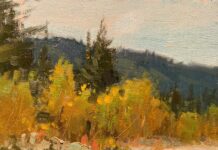Plein Air Painting Events > Mary Longe explains why you should consider a competitive plein air event, including the various types, common elements, and more.
Does Your Plein Air Painting Experience Need a Recharge?
By Mary Longe
(Former Director of the Plein Air Painters Chicago)
Need a new challenge in plein air painting? Maybe a plein air competition is a possibility, but you’re feeling a bit intimidated? There are loads of events from which to choose, so here are a few thoughts as you consider registering.
Why and how we paint is inextricably linked to our lifestyle and personality. To navigate a competitive event to its fullest potential it’s critical to keep in mind our personal and artistic objectives, as well as the goals of event organizers.
For artists, plein air competitions can simply be social or a way to travel alone to be with other people. They can be used to achieve a personal best under pressure of rivalry, unfamiliar locations, time and weather, or offer a path to artistic success. Some events offer the artist income, national recognition, representation by galleries, or acquisition by museums.
Visit the website of the host organization. It usually provides their stated mission and goals; the “About” the organizer gives their raison d’être. The description and prospectus explain the elements and rules of the event. What sparks your fancy? Is it socializing, education, winning, income, recognition? Perhaps you are hoping to find representation by a gallery, or have a piece acquired by a museum? Whether participating or not, these benefits of painting competitions can support artists on their paths when making art as a hobby or professionally.
Organizers may be solely dedicated to advancing plein air painting, or art in general. A municipality may be seeking status as an art community, or an educational center may be expanding their art programming or generating income. Some plein air painting competitions are built into larger art fairs where studio art or sculpture may also be included.
Events vary in financial objectives, scope, number of artists and judges, length, allowed media, prizes, rules of engagement, types of paint outs, sales events for the public, social events for the artists, and volume and size of sales. Understanding the organizer’s objectives for an event will help the artist in selecting events with a good fit.
Consider the organizer’s financials, which will offer you insights into an event. Registration fees typically cover the sunk costs – promotion, signs, t-shirts, food services, and rentals for sound equipment or a temporary gallery. If an event is funded by grants and donations, the funders likely have an interest in fulfilling their community or arts mission, and appreciate the greater visibility. Financial sponsors generally subsidize events at larger amounts, which allow organizers to offer more elaborate event programming or prize money. In turn, they may have more leverage with the organizers on how they are recognized for their contributions. Large sponsorships typically are budgeted items that come from a marketing department looking for visibility and followers and find it in having naming rights on awards and their logos on each and every promotion, t-shirt and social announcement.
Municipalities coordinating events often partner with local organizations like libraries, history museums, parks, and local merchants. Artworks may be hung in different locations and not together. Financial sponsors for local and regional events are frequently local merchants related to art, restaurants, galleries, or museums. It’s good form to support the sponsors. When you are at a local merchant, thank them for their sponsorship. Grateful, spending artists will go a long way in the organizer receiving continued support.
If an event is focused on fundraising or income generation, it’s likely to have multiple sales venues. Here are a few:
- Typically, events take a commission, a small percentage of all sales. Usually 30% with 70% going to the artist.
- Some have mini-exhibits, maybe at the site of a quick paint (a 2–4-hour paint out), where artists show their art on their easel (some artists bring collapsible display easels) and sell it through the organizer. By the way, it’s bad form to sell your art directly to the public from your easel during a competition, instead invite them to the exhibition, or suggest they arrange with the organizer to reserve it.
- A few events charge entry fees for the public or vip collectors to receptions. Most events charge commission on sales of art; and artists, by the way, should price their works accordingly.
- Some allow and even encourage artists to bring works of art created prior to the event to replace any sold during sales events.
- You’ll find auctions, online sales, and pre-sold VIP receptions, some with a portion of that ticket, a $100 for example, as a coupon toward buying a painting.
- They may allow and even encourage artists to bring more works of art, created prior to the event to replace any sold during receptions and sales events.
Take a few minutes to consider how an event is financed, then consider if you will find value in what they are offering. Your competition experience will be best when it aligns with your interests.

Types of Competitive Art Events
Each plein air competition is a bit different from the next, but they generally fall into four types, with varied events and programs.
- Invitational – Preeminent plein air artists are invited to a nationally recognized event; the regulars refer to this as “the circuit.” These are the most competitive and offer the biggest prizes. In most cases, artists have out of pocket costs for some or all housing, food and transportation.
- Juried Selection– Artists apply online to participate by submitting artwork, and a juror or jury selects the artists to participate. Artists usually pay a registration fee, are responsible for all expenses, and not guaranteed a spot.
- Open Registration – Organizers invite all artists to participate and with a certain quantity of spots available. These are often regional or locally focused and a terrific way to become initiated in competitive events. Artists are on the hook for expenses, but often, costs are less than other types.
- Hybrid – Most events are a combination of these. How they are executed typically depends on the primary sponsor and the stated and unstated goals for the event.
Common Elements
- Camaraderie – Painting is such a solo endeavor, so when there’s an opportunity to collaborate with fellow artists, everyone wins
- Set physical boundaries for paint outs, which may change during the event
- Rules of engagement
– Stamped surfaces – Panels need to be stamped before painting or drawing to confirm everyone is starting with a literal blank canvas. Check the rules whether you are allowed to use a pre-toned canvas
– Mediums allowed – Typically, all paint or drawing mediums are allowed
– Percentage of painting that can be done out of the scene, (0% for many.)
– Use of cameras and cell phones – mostly not allowed. You may need to go old school with thumbnail sketches and grid lines.
– Adherence to timeframes - Submission guidelines
– Scheduled deadlines – daily or end of event
– Quantity and size of paintings allowed
– Frames and wiring
– Provision and placement of information regarding title, medium, artist name, price - Prizes or recognition of art works
- Opportunities to show and sell work to public
Competitive Aspects
Everyone’s a winner in a plein air painting competition, but some people get prizes. How competitions are decided varies. The deciders are typically:
- an individual judge
- a panel of judges
- peers, or
- the public.
Judges may or may not be local. Some shows have artists place their title and name cards on the back of pieces for the judging process. Some events employ artists, often instructors who do not paint en plein air, who judge the art and aren’t swayed by plein air trends. Some shows use the winner of the previous year.
Judges usually have a brief amount of time to review and assess sometimes hundreds of paintings. Finding winners can be daunting when an event with 100 artists allows 3 submissions each. Some shows use apps, others use Post-it notes or check lists to winnow down to winners.
I’ve been told by judges that the first cut is pretty quick as they look for the basics: compositional design, movement, perspective, values, and luminescence or light. More time is needed to make subsequent passes and final decisions. It’s not unusual that peers and the public vote in addition to the judges, and prizes are awarded to winners of those polls. Some events stage auctions where invited artists may submit a single painting with their minimum opening bid. Competition among the buyers is a signal (to buyers, collectors, and galleries) that the artist is collectable.

Prizes
Cash is the most frequent acknowledgement of excellence in the events. Larger amounts and a higher number of purses draw professional artists to an event. Having professional artists with recognizable names theoretically brings more art collectors, which symbiotically serves the artists. Other prizes include:
- Equipment
- Invitation to return the following year
- Purchase of the winning painting by a museum or other entity
- An invitation to judge the following year
Stay tuned! Next, Mary Longe will share an article on “How to Prepare for Plein Air Painting Competitions.”
Related Article by Mary Longe > Plein Air Painting and Personal Safety
Visit EricRhoads.com to find out all the amazing opportunities for artists through Streamline Publishing, including:
– Online art conferences such as Plein Air Live
– New video workshops for artists
– Incredible art retreats
– Educational and fun art conventions, and much more.
> Subscribe to Plein Air Today, a free newsletter for artists
> Subscribe to PleinAir Magazine so you never miss an issue





